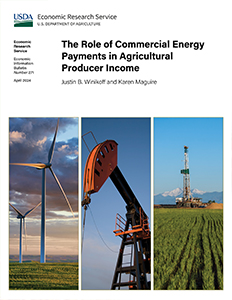The Role of Commercial Energy Payments in Agricultural Producer Income
- by Justin B. Winikoff and Karen Maguire
- 4/23/2024
Overview
A significant portion of energy production in the United States takes place on farmland, which can have substantial economic implications for the farmers who host such developments. This report analyzes energy payments made to farmers for the production of oil, natural gas, and wind energy on their land. The authors used 10 years of data (2011–20) from the USDA’s Agricultural Resource Management Survey (ARMS) in their analysis. Results show that 3.5 percent of farm operations received energy payments and that the average annual payment to the operators was more than $30,000 (in 2020 dollars), contributing substantially to farm household income and exceeding government payments to these operations. Energy payments were more common in counties producing oil and natural gas than in those with wind energy development. Larger farms were significantly more likely to receive energy payments and received higher payments on average. Further, Hispanic producers and those with less education were significantly less likely to receive energy payments. Although the average energy payment varied by ethnicity and education status, this report did not find a statistically significant difference after accounting for farm location and size.
How to Cite:
Winikoff, J.B., & Maguire, K. (2024). The role of commercial energy payments in agricultural producer income (Report No. EIB-271). U.S. Department of Agriculture, Economic Research Service. https://doi.org/10.32747/2024.8374827.ers
Download
-
Entire report
Download PDF -
Report summary
Download PDF


